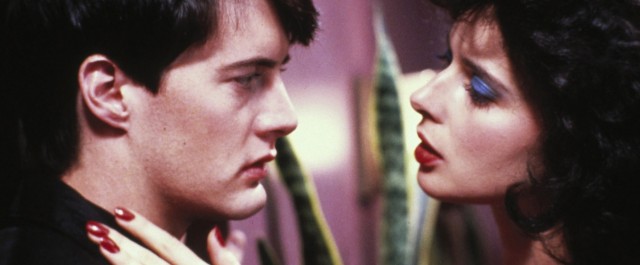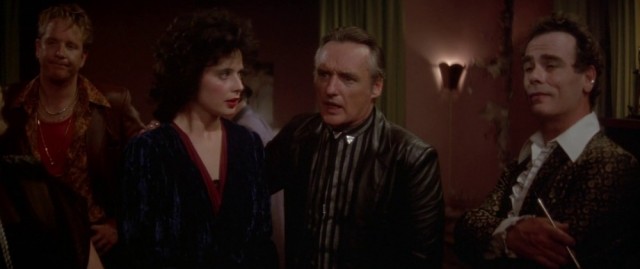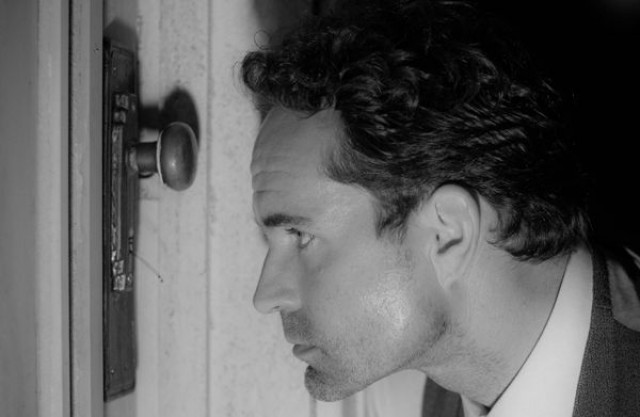
Jeffrey Beaumont (Kyle MacLachlan) gets introduced to a dangerous, candy-coated world by Dorothy Vallens (Isabella Rossellini) in David Lynch’s BLUE VELVET
BLUE VELVET (David Lynch, 1986)
BAMcinématek, BAM Rose Cinemas
30 Lafayette Ave. between Ashland Pl. & St. Felix St.
Saturday, August 8, 4:30 & 9:30
Series continues through August 27
718-636-4100
www.bam.org
 David Lynch reveals the dark underbelly of American society in his 1986 masterpiece, Blue Velvet. Channeling Douglas Sirk and Alfred Hitchcock as well as John Badham’s War Games, Lynch creates a unique look and feel in this modern erotic noir thriller, set in the small suburban town of Lumberton, North Carolina, where danger and darkness lurk just below the surface. Lynch, who had previously made the well-received Eraserhead and The Elephant Man as well as the disastrous Dune, establishes the American theme at the heart of the movie with Blue Velvet’s opening shot, red roses in front of a white picket fence with a bright blue sky in the background. As the soundtrack plays Bobby Vinton’s 1963 hit version of the title song, Lynch then shows a red fire truck moving in slow motion down a tree-lined street, a fireman in a blue shirt on the truck, waving, standing next to a Dalmatian; children being beckoned across a street by a crossing guard; a woman (Priscilla Pointer) on her couch watching a black-and-white crime movie in which a man with a gun enters a living room; and her husband (Jack Harvey) suffering a heart attack while watering the lawn, the hose shooting out from his groin area as he lies on the ground. Lynch then zooms in on a human ear in a windy green field, the organ being devoured by bugs, followed by a billboard announcing, “Welcome to Lumberton.” That’s quite a welcome, indeed. Lynch begins the main narrative as college student Jeffrey Beaumont (Kyle MacLachlan) visits his father in the hospital, then finds that now-ant-covered ear in the field. The camera swoops in closer and closer, finally taking viewers inside the detached organ, and the story takes off, as Jeffrey and high school student Sandy (Laura Dern), the daughter of local police detective John Williams (George Dickerson), get involved with a group of demented, crazed criminals led by the deranged Frank Booth (Dennis Hopper), who are abusing singer Dorothy Vallens (Isabella Rossellini) while apparently holding her husband and son hostage. The more Jeffrey immerses himself in this maniacal, candy-coated world, the more peril he finds himself in as his relationships grow with both Sandy and Dorothy.
David Lynch reveals the dark underbelly of American society in his 1986 masterpiece, Blue Velvet. Channeling Douglas Sirk and Alfred Hitchcock as well as John Badham’s War Games, Lynch creates a unique look and feel in this modern erotic noir thriller, set in the small suburban town of Lumberton, North Carolina, where danger and darkness lurk just below the surface. Lynch, who had previously made the well-received Eraserhead and The Elephant Man as well as the disastrous Dune, establishes the American theme at the heart of the movie with Blue Velvet’s opening shot, red roses in front of a white picket fence with a bright blue sky in the background. As the soundtrack plays Bobby Vinton’s 1963 hit version of the title song, Lynch then shows a red fire truck moving in slow motion down a tree-lined street, a fireman in a blue shirt on the truck, waving, standing next to a Dalmatian; children being beckoned across a street by a crossing guard; a woman (Priscilla Pointer) on her couch watching a black-and-white crime movie in which a man with a gun enters a living room; and her husband (Jack Harvey) suffering a heart attack while watering the lawn, the hose shooting out from his groin area as he lies on the ground. Lynch then zooms in on a human ear in a windy green field, the organ being devoured by bugs, followed by a billboard announcing, “Welcome to Lumberton.” That’s quite a welcome, indeed. Lynch begins the main narrative as college student Jeffrey Beaumont (Kyle MacLachlan) visits his father in the hospital, then finds that now-ant-covered ear in the field. The camera swoops in closer and closer, finally taking viewers inside the detached organ, and the story takes off, as Jeffrey and high school student Sandy (Laura Dern), the daughter of local police detective John Williams (George Dickerson), get involved with a group of demented, crazed criminals led by the deranged Frank Booth (Dennis Hopper), who are abusing singer Dorothy Vallens (Isabella Rossellini) while apparently holding her husband and son hostage. The more Jeffrey immerses himself in this maniacal, candy-coated world, the more peril he finds himself in as his relationships grow with both Sandy and Dorothy.

Dennis Hopper restarted his career with memorable performance as the maniacal Frank Booth in BLUE VELVET
Like the true surrealist he is, Lynch populates Blue Velvet with all kinds of insects, from the ants and other creepy crawly things on the dismembered ear to a bug a robin brings to the Beaumont kitchen; when Frank Booth puts on his oxygen mask to suck in an unidentified drug that most likely is nitrous oxide or amyl nitrate, he resembles a bug, and when Jeffrey needs to gain access to Dorothy’s apartment, he pretends to be an exterminator — and is spotted by the man in the yellow jacket (Fred Pickler). Lynch doesn’t overplay his hand; he deleted a scene involving Aunt Barbara’s (Frances Bay) obsession with termites; the story does take place in Lumberton, after all. The American dream turns into an American nightmare as Lynch also turns Roy Orbison’s “In Dreams” into a theme fraught with menace, lip-synced by the very strange Ben (Dean Stockwell) and mimicked with evil glee by the maniacal Booth. The song, which includes the key line “Too bad it only seems / It only happens in my dreams,” has led some to consider that most of the film is a dream, taking place in Jeffrey’s head from the time the camera zooms into the ear and then eventually emerges near the end. (It would also help explain why high school student Sandy is wearing a ring on her wedding finger throughout the movie.) Even the casting and character names are filled with tantalizing references: Sandy’s mother is played by Hope Lange, who was nominated for an Oscar for her performance as Selena Cross in Peyton Place, a film about a different underside to an American town; Stockwell was a child actor who starred in such films as The Boy with Green Hair and later as a cold-blooded killer in Compulsion; and even the Beaumont family name evokes Hugh Beaumont, who played the patriarch of the Cleaver (!) family in Leave It to Beaver. It’s also extra difficult to watch Vallens get so physically and emotionally abused, knowing that she is played by the daughter of one of cinema’s most beloved and beautiful stars, Ingrid Bergman; Rossellini gives a brave and courageous career-defining performance as a wife and mother who will do anything to get her family back. Nearly thirty years old, Blue Velvet holds up marvelously well, as dark and depraved, and as shimmering and vibrant, as ever, set in a luridly colored world stunningly photographed by Frederick Elmes and featuring a haunting throwback score by Angelo Badalamenti, a frightening yet appealing world that Lynch turns upside down and inside out. Blue Velvet is screening August 8 as part of the BAMcinématek series “Indie 80s,” which continues through August 27 with such other seminal ’80s films as the Coen brothers’ Blood Simple, Gregory Nava’s El Norte, Hal Hartley’s The Unbelievable Truth, and Sam Raimi’s The Evil Dead.

 Inspired by Homer’s Odyssey, Gaston Bachelard’s The Poetics of Space, and the Bowery Boys’ Spooks Run Wild, Canadian experimental filmmaker
Inspired by Homer’s Odyssey, Gaston Bachelard’s The Poetics of Space, and the Bowery Boys’ Spooks Run Wild, Canadian experimental filmmaker